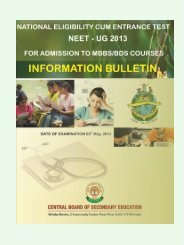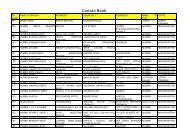Examination Syllabus - NEET-UG, 2013
Examination Syllabus - NEET-UG, 2013
Examination Syllabus - NEET-UG, 2013
Create successful ePaper yourself
Turn your PDF publications into a flip-book with our unique Google optimized e-Paper software.
UNIT VII: Properties of Bulk Matter<br />
Elastic behavior, Stress-strain relationship. Hooke’s law, Young’s modulus, bulk modulus, shear, modulus of rigidity,<br />
poisson’s ratio; elastic energy.<br />
Viscosity, Stokes’ law, terminal velocity, Reynold’s number, streamline and turbulent flow. Critical velocity, Bernoulli’s<br />
theorem and its applications.<br />
Surface energy and surface tension, angle of contact, excess of pressure, application of surface tension ideas to drops,<br />
bubbles and capillary rise.<br />
Heat, temperature, thermal expansion; thermal expansion of solids, liquids, and gases. Anomalous expansion. Specific heat<br />
capacity: Cp, Cv- calorimetry; change of state – latent heat.<br />
Heat transfer- conduction and thermal conductivity, convection and radiation. Qualitative ideas of Black Body Radiation,<br />
Wein’s displacement law, and Green House effect.<br />
Newton’s law of cooling and Stefan’s law.<br />
UNIT VIII: Thermodynamics<br />
Thermal equilibrium and definition of temperature (zeroth law of Thermodynamics). Heat, work and internal energy. First<br />
law of thermodynamics. Isothermal and adiabatic processes.<br />
Second law of the thermodynamics: Reversible and irreversible processes. Heat engines and refrigerators.<br />
UNIT IX: Behaviour of Perfect Gas and Kinetic Theory<br />
Equation of state of a perfect gas, work done on compressing a gas.<br />
Kinetic theory of gases: Assumptions, concept of pressure. Kinetic energy and temperature; degrees of freedom, law of<br />
equipartition of energy (statement only) and application to specific heat capacities of gases; concept of mean free path.<br />
UNIT X: Oscillations and Waves<br />
Periodic motion-period, frequency, displacement as a function of time. Periodic functions. Simple harmonic motion(SHM)<br />
and its equation; phase; oscillations of a spring-restoring force and force constant; energy in SHM –Kinetic and potential<br />
energies; simple pendulum-derivation of expression for its time period; free, forced and damped oscillations (qualitative<br />
ideas only), resonance.<br />
Wave motion. Longitudinal and transverse waves, speed of wave motion. Displacement relation for a progressive wave.<br />
Principle of superposition of waves, reflection of waves, standing waves in strings and organ pipes, fundamental mode and<br />
harmonics. Beats. Doppler effect.<br />
UNIT I: Electrostatics<br />
CONTENTS OF CLASS XII SYLLABUS<br />
Electric charges and their conservation. Coulomb’s law-force between two point charges, forces between multiple charges;<br />
superposition principle and continuous charge distribution.<br />
Electric field, electric field due to a point charge, electric field lines; electric dipole, electric field due to a dipole; torque on a<br />
dipole in a uniform electric field.<br />
Electric flux, statement of Gauss’s theorem and its applications to find field due to infinitely long straight wire, uniformly<br />
charged infinite plane sheet and uniformly charged thin spherical shell (field inside and outside)<br />
Electric potential, potential difference, electric potential due to a point charge, a dipole and system of charges:<br />
equipotential surfaces, electrical potential energy of a system of two point charges and of electric diploes in an electrostatic<br />
field.<br />
Conductors and insulators, free charges and bound charges inside a conductor. Dielectrics and electric polarization,<br />
capacitors and capacitance, combination of capacitors in series and in parallel, capacitance of a parallel plate capacitor with<br />
and without dielectric medium between the plates, energy stored in a capacitor, Van de Graaff generator.





